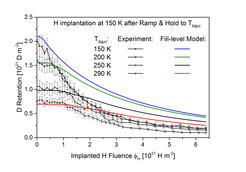Hydrogen Isotope Exchange in Tungsten at Low Temperatures
Hydrogen is retained in tungsten by bonding to lattice defects. Details of this bonding play a decisive role in diffusion, retention and permeation in or through tungsten. This determines how much tritium can accumulate in tungsten.

Basic properties of the bonding of hydrogen to defects in tungsten were investigated 'in-situ' at the tandem accelerator in exchange experiments with the two isotopes hydrogen and deuterium at low temperatures. The experimental results were compared with two different models, the established “classical model”, which assumes a single hydrogen isotope atom to be trapped in a defect, and a newly devised “fill-level model”, which allows multiple hydrogen isotope atoms in one defect. It was shown that the “classical model” cannot account for the observed isotopic exchange – in contrast to the “fill-level” model. Only when the kinetic release of deuterium by collisions with ions impinging from the plasma is taken into account the results can be described consistently with both models. These investigations are important for predicting the tritium retention in fusion reactors.
With this work Johannes Bauer received his PhD at the TU München in January 2018. The thesis is available under the following link:
http://hdl.handle.net/21.11116/0000-0000-3B0E-0
One aspect of this thesis has already been published in Nuclear Fusion:
J. Bauer, T. Schwarz-Selinger, K. Schmid, M. Balden, A. Manhard, and U. von Toussaint:
“Influence of Near-Surface Blisters on Deuterium Transport in Tungsten”
Nuclear Fusion, 57, 086015 (2017). doi: 10.1088/1741-4326/aa7212
https://doi.org/10.1088/1741-4326/aa7212
